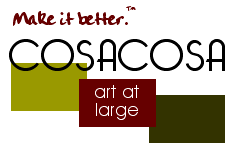



My friends and I often comment about art and daily life on the streets of Philadelphia: if it moves, it's performance; if it stands still, it's installation. This observation is not meant to be glib. As community-based artists living and working in our city's neighborhoods, we recognize how inextricably art and life are intertwined. Truly, here in our most challenged neighborhoods, art is an essential expression of our heartfelt needs and a necessary means for our survival -- as individuals and as a community.
We often forget that art and everyday life were inseparable for thousands of years, and still are in traditional cultures. We forget that, in such communities, everyone is considered an artist. We forget that many of the "artworks" we see in our museums merely were created in and from the routines and rituals of living. Indeed, from ceramics to weavings, from carvings to paintings, these objects facilitated everyday life. We've lost the sense of these artworks' original functions -- from the mundane (a cup from which to drink) to the sublime (a mask through which to heal). We've lost our understanding of this art of living -- as individuals and as a community.
Well, perhaps not all of us.
The inner city residents and "at risk" youth with whom I collaborate on public art projects quickly come to realize how working together creatively builds their community. Here, where the majority of people lack the most basic needs of life -- safety, shelter, food -- art becomes the means through which to proactively address common interests and concerns, while building a collective vision of a healthy community. Thinking and acting creatively -- applying those strategizing, planning, and cooperating skills learned in communal art-making -- engenders the self-determination necessary to solve many neighborhood problems.
As community-based artists we serve as interpreters, intermediaries, and guides to this process. Every day through art, young people reconnect with older neighbors to discover their shared history, even as the strengths of one generation are applied to the other. Every day through art, people of different cultures, backgrounds, and abilities learn to embrace their similarities and reconcile their differences. Every day through art, difficulties that once seemed insurmountable are confronted, engaged, and addressed.
So, even now, art's essential function remains utilitarian -- the preservation of memory, the building of bridges, the exploration of the difficult or the unknown. Art incarnates both origin and vanguard for every society. And here, on our city's most ravaged streets -- amid the poverty, the violence, the trash, and the drugs -- the art of survival becomes the art of living creatively.
As it was in the beginning, it's an everyday art.
Philip Dit Wah Deng Tang is an interdisciplinary artist working for cultural change in Philadelphia neighborhoods and co-founder of COSACOSA art at large, Inc. His projects with COSACOSA include Connection, an 80' x 5' ceramic mural at the Philadelphia International Airport, created as a city-wide collaboration among Philadelphia youth to explore their common needs and hopes; Mask and Metaphor, a year-long project exploring cross-cultural and community identity; and numerous public art works for our Healing Art Project.
We often forget that art and everyday life were inseparable for thousands of years, and still are in traditional cultures. We forget that, in such communities, everyone is considered an artist. We forget that many of the "artworks" we see in our museums merely were created in and from the routines and rituals of living. Indeed, from ceramics to weavings, from carvings to paintings, these objects facilitated everyday life. We've lost the sense of these artworks' original functions -- from the mundane (a cup from which to drink) to the sublime (a mask through which to heal). We've lost our understanding of this art of living -- as individuals and as a community.
Well, perhaps not all of us.
The inner city residents and "at risk" youth with whom I collaborate on public art projects quickly come to realize how working together creatively builds their community. Here, where the majority of people lack the most basic needs of life -- safety, shelter, food -- art becomes the means through which to proactively address common interests and concerns, while building a collective vision of a healthy community. Thinking and acting creatively -- applying those strategizing, planning, and cooperating skills learned in communal art-making -- engenders the self-determination necessary to solve many neighborhood problems.
As community-based artists we serve as interpreters, intermediaries, and guides to this process. Every day through art, young people reconnect with older neighbors to discover their shared history, even as the strengths of one generation are applied to the other. Every day through art, people of different cultures, backgrounds, and abilities learn to embrace their similarities and reconcile their differences. Every day through art, difficulties that once seemed insurmountable are confronted, engaged, and addressed.
So, even now, art's essential function remains utilitarian -- the preservation of memory, the building of bridges, the exploration of the difficult or the unknown. Art incarnates both origin and vanguard for every society. And here, on our city's most ravaged streets -- amid the poverty, the violence, the trash, and the drugs -- the art of survival becomes the art of living creatively.
As it was in the beginning, it's an everyday art.
Philip Dit Wah Deng Tang is an interdisciplinary artist working for cultural change in Philadelphia neighborhoods and co-founder of COSACOSA art at large, Inc. His projects with COSACOSA include Connection, an 80' x 5' ceramic mural at the Philadelphia International Airport, created as a city-wide collaboration among Philadelphia youth to explore their common needs and hopes; Mask and Metaphor, a year-long project exploring cross-cultural and community identity; and numerous public art works for our Healing Art Project.
Artolatry bread image after Salvadore Dalí's Basket of Bread (1926).